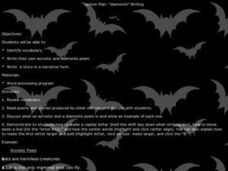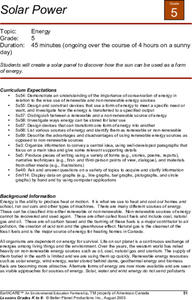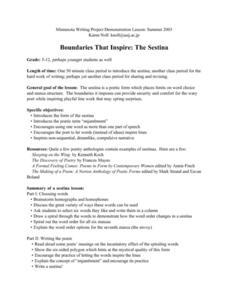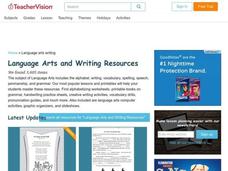Curated OER
Creative Writing
Students determine what grammar is and how they have learned it. In this creative writing lesson, students read "Style' Gets New Elements," and respond to the discussion questions. Students then present grammatical rules to one another...
Curated OER
Say Hi to Haibun Fun
What is a haibun? With this interesting lesson, writers will experience the Japanese writing form haibun, identify elements important to Japanese writing styles, analyze a haibun, and compose their own. Different from the typical journal...
Curated OER
Language Arts: Lewin Project
Fourth graders read and respond to the poem, "When I Am Angry." They complete surveys by analyzing the most common feeling and draw a bar graph of their behavior, using different colors to identify the duration of various feelings. ...
Curated OER
Conservation of Energy
Fifth graders examine their use of energy over a certain time period. They come up with a plan to reduce their energy consumption and carbon footprint. Groups of learners complete a chart with three columns; energy-using events, the form...
University of Arizona
Yoruba Legends: Southern Nigeria
Explore legends and storytelling with your learners. After listening to some legends, pupils work collaboratively and then individually to come up with original legends about animals.
Curated OER
The Highwayman
Fifth graders re-read the story "The Highwayman" understanding the term "narrative verse". As a paired activity, they predict who or what might be the audience and provide feedback.
Curated OER
Diamonte Writing
Students discover poetry while practicing their storytelling skills. For this language arts lesson, students read diamonte and acrostic poems written by other students on the Internet. Students create their own narrative stories about...
Curated OER
Lesson Plan for Waiting to Waltz: A Childhood by Cynthia Rylant
Sixth graders examine the elements of writing poetry. In this creative writing activity, 6th graders discuss a book of poetry in the setting of Appalachia. Students incorporate childhood experiences into the development of visual and...
Curated OER
Adventures in Alice
Students create a haiku and illustrate it on the computer. In this haiku lesson plan, students review the history of the haiku while they are outside and then write their own. Students then use a computer program to illustrate their poem.
Curated OER
Out of the Dust
Students create a poem that expresses the physical and emotional turmoil of living through the Dust Bowl. In this Out of the Dust lesson, students research facts about the time period and discuss the cause-effect patterns associated...
Curated OER
Humans and the Natural World Poetically
Students read poetry for gist and find images to create a visual narrative. In this poetry lesson, students read Green Lane and Flies and Nettles to examine the relationship between humanity and the nature. Students reflect on a place...
Curated OER
Solar Power
Fifth graders create their own solar panel. They use this experiment to see how the sun can be used as a form of energy.
Curated OER
Lesson Plan 3: Great Book, Gross Book
It's time for your scholars to become book reviewers! Start with a fun review of foods: are they good or gross? Learners apply these evaluation techniques to books, recording their thoughts on large pieces of butcher paper. Simply have...
Curated OER
Jazz Talk
Middle schoolers analyze the origins of jazz music by examining work songs, spirituals, blues, and gospel songs as well as works of poetry from African American artists. They create their own poems from either the narrative, dramatic,...
Curated OER
Silent Stories
Students create a pictorial narrative based upon John Keats' "Ode on a Grecian Urn" and the Japanese techniques of "lacquer jar" stories in this three-day Language Arts/Art lesson.
Curated OER
CREATE A NEW RHYME
Third graders develop basic narratives. They retell a focused story and create a basic publication using available resources (e.g., pictures, colors, computer, copier). They experiment with different forms of creative writing (e.g.,...
Curated OER
Poetic Analysis
Students write a poetic analysis on a poem by Carl Sandburg. They take their previous knowledge of poetic devices and apply them to a piece of writing that displays their knowledge on a specific poem. They explain what they know about a...
Curated OER
Illuminating Our Human Experiences: Soliloquy from Hamlet
Students determine the meaning of a soliloquy and examine the themes in Shakespeare's, Hamlet. For this literature lesson, students read Hamlet's soliloquy and watch a Photo Story 3 text model of such. They write a personal soliloquy...
Curated OER
An Ancient Revolution: The Written Word
Students examine the Bible, one of the earliest written sources, as a compilation of narratives, and search the resources on the HERITAGE DVD-ROM for historical "proof" as well as create their own stories and scripts based on ancient...
Curated OER
Boundaries That Inspire: The Sestina
Young scholars study the poetic term "enjambment". They use one word as more than one part of speech and let words (instead of ideas) inspire lines and non-sequential, dreamlike, compulsive narrative.
Curated OER
Read "El Corrido de Gregorio Cortez"Americo Paredes version
Students see examples of other types of written stories. They are introduced to the ballad in literature. Students obtain ideas for their own family story. They discuss how ballads can relate true stories through music. Students discuss...
Curated OER
I Know Why the Caged Bird Sings
Students read and analyze the novel "I Know Why the Caged Bird Sings" by Maya Angelou. They discuss the poetry and prose of the book, the importance of role models, complete a worksheet, and write a narrative using figurative language.
Curated OER
Stain My Days Blue
Students read several poems related to the life and culture of the Appalachia region. They are introduced to the poetic forms of simile, alliteration and onomatopoeia and respond to the poems through journal entries and poetry of their own.
Curated OER
Reader's Theater
Students act out and interpret the story for their peers. They study the simplest form of an organized reading to a more elaborate activity involving props, costumes, or a reinterpretation of the narrative into another art form.

























